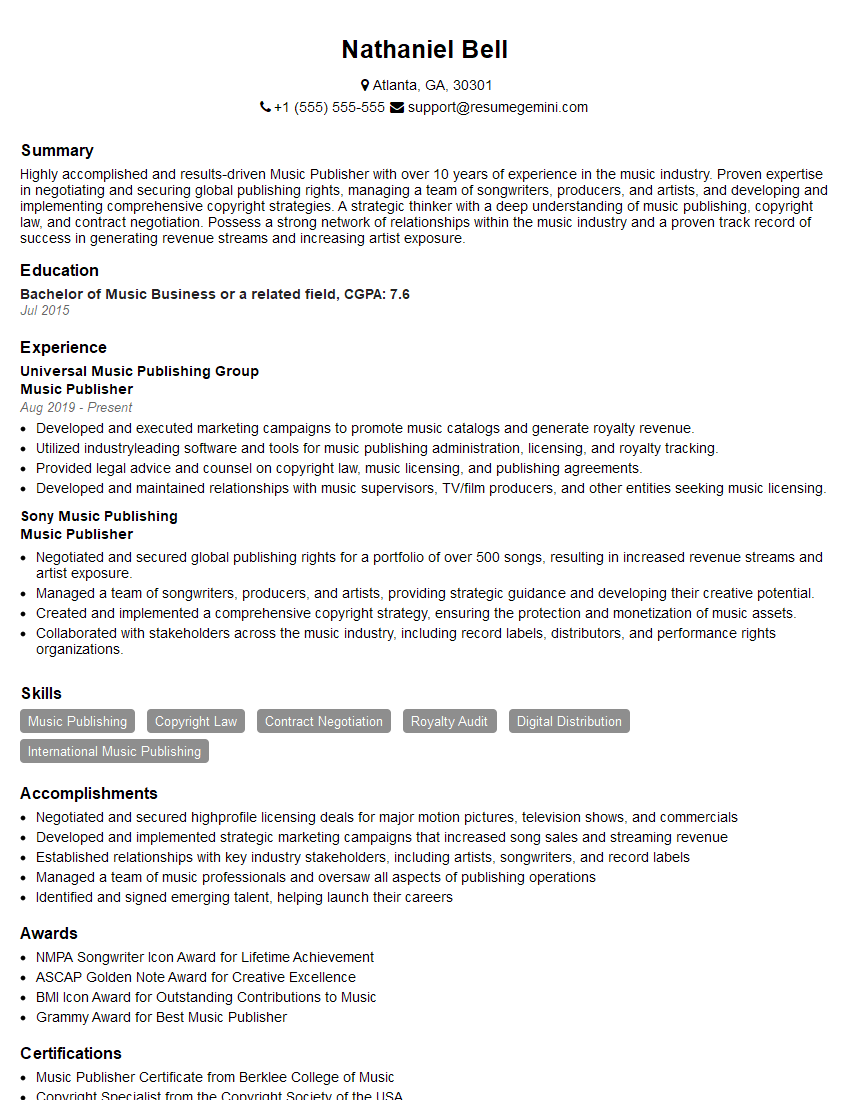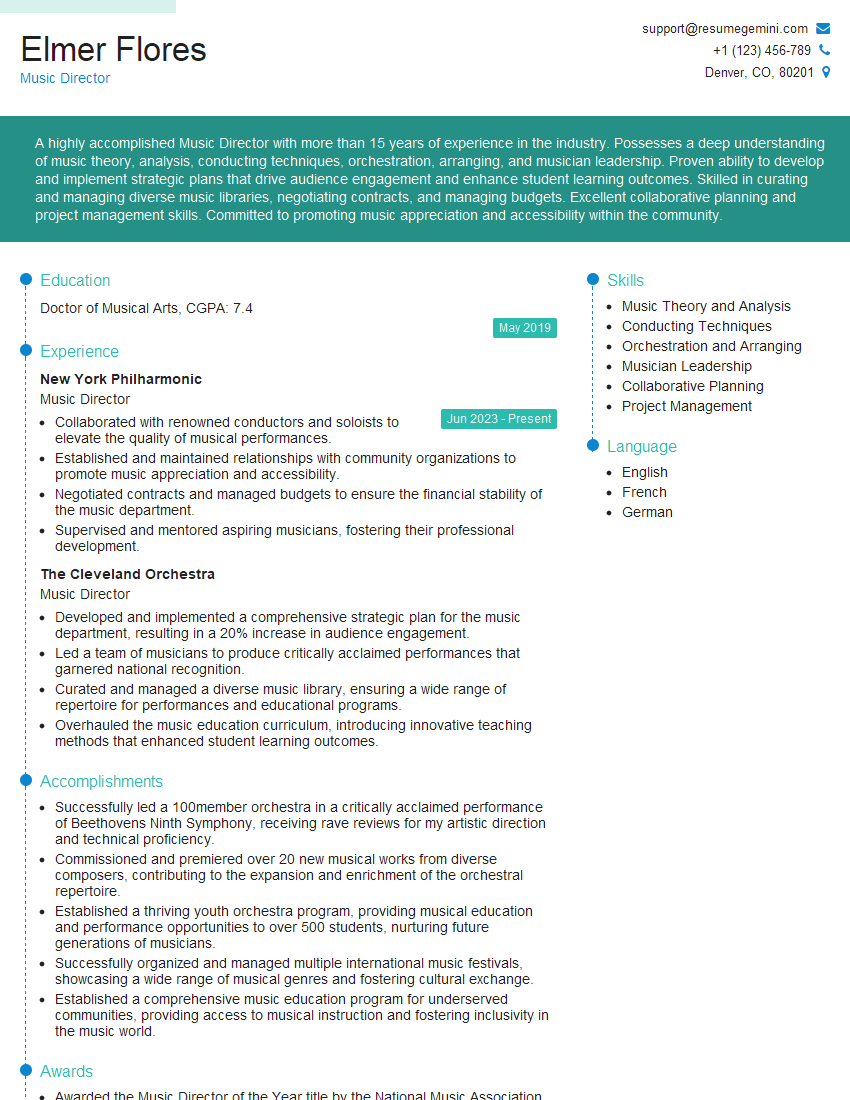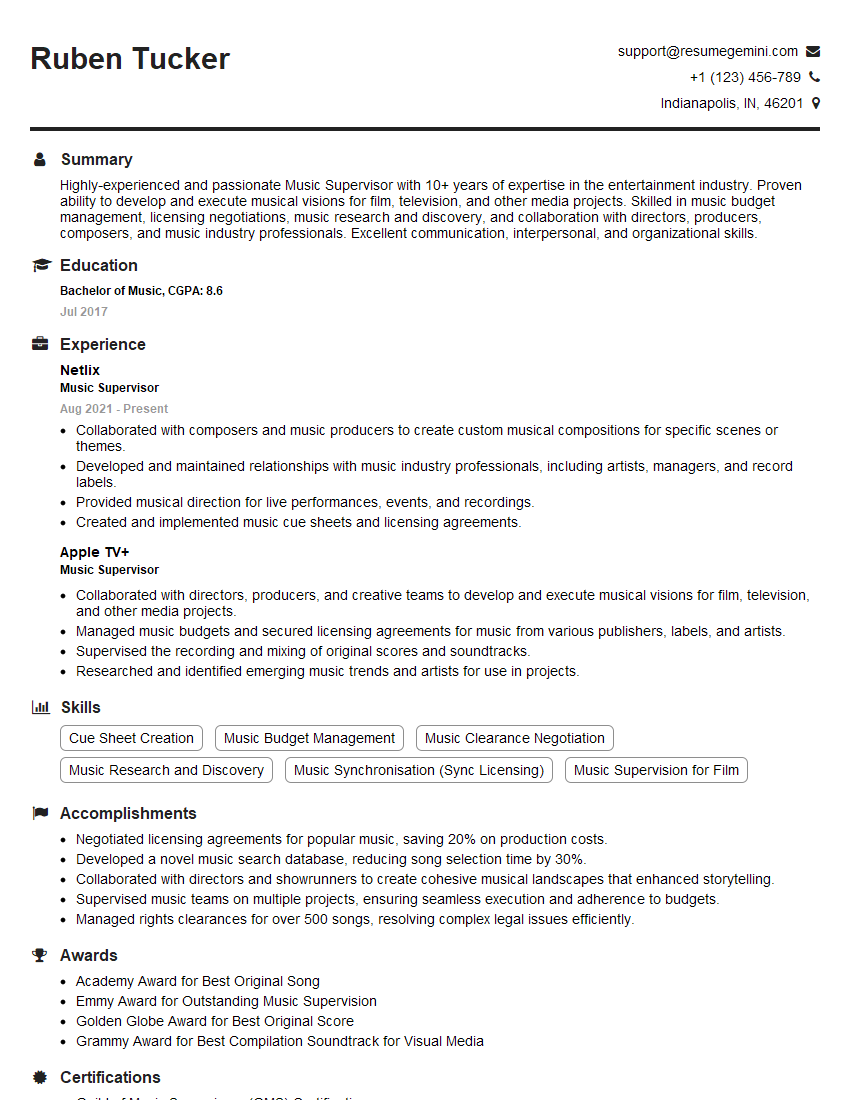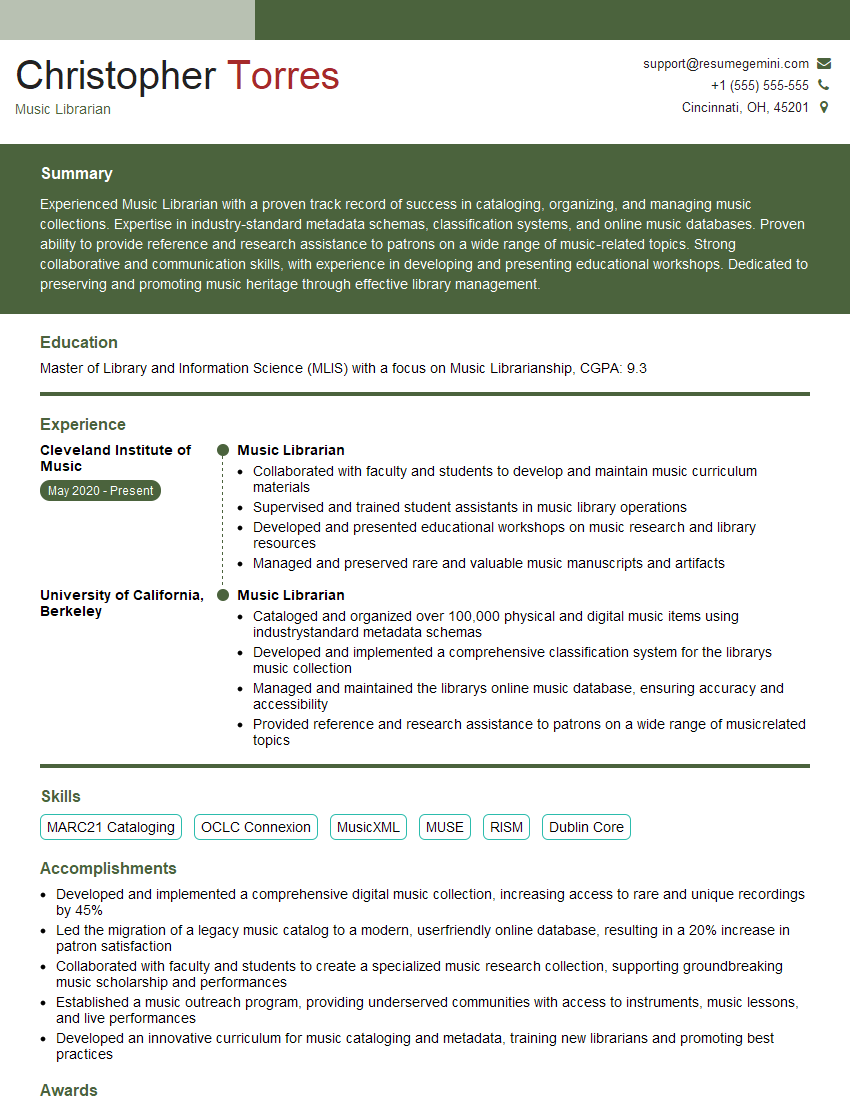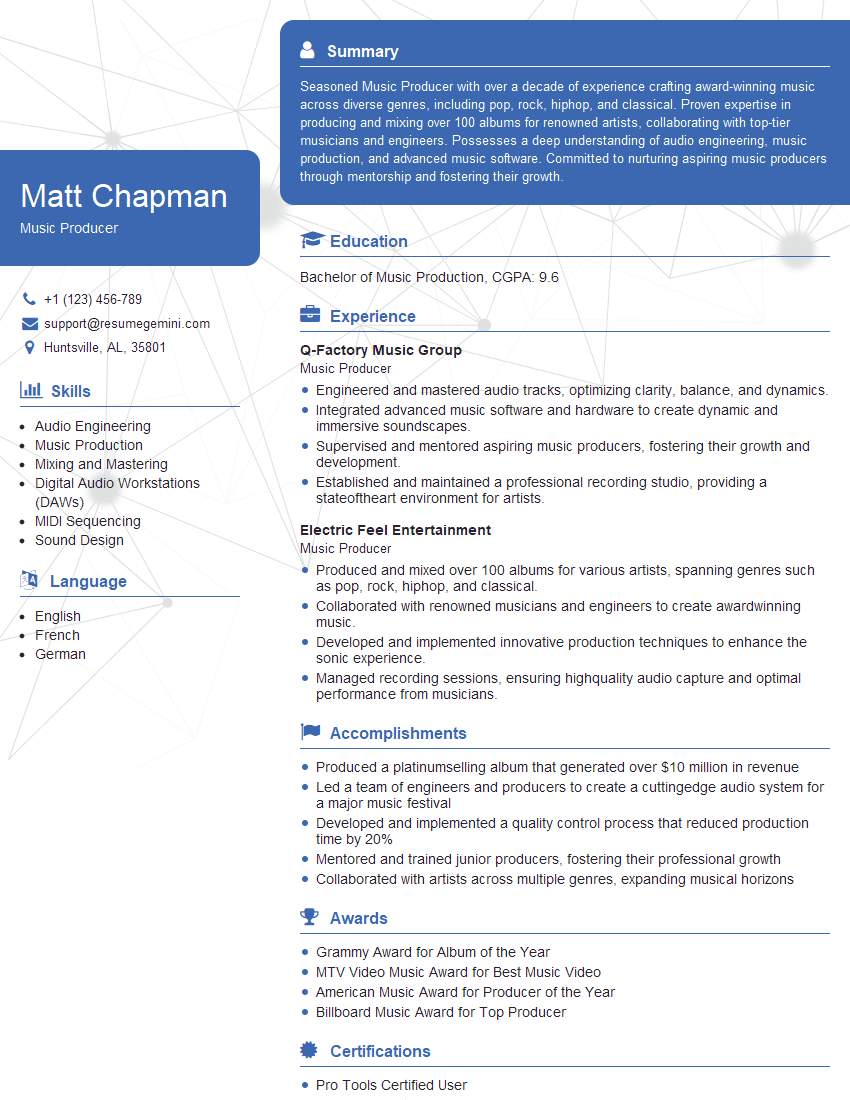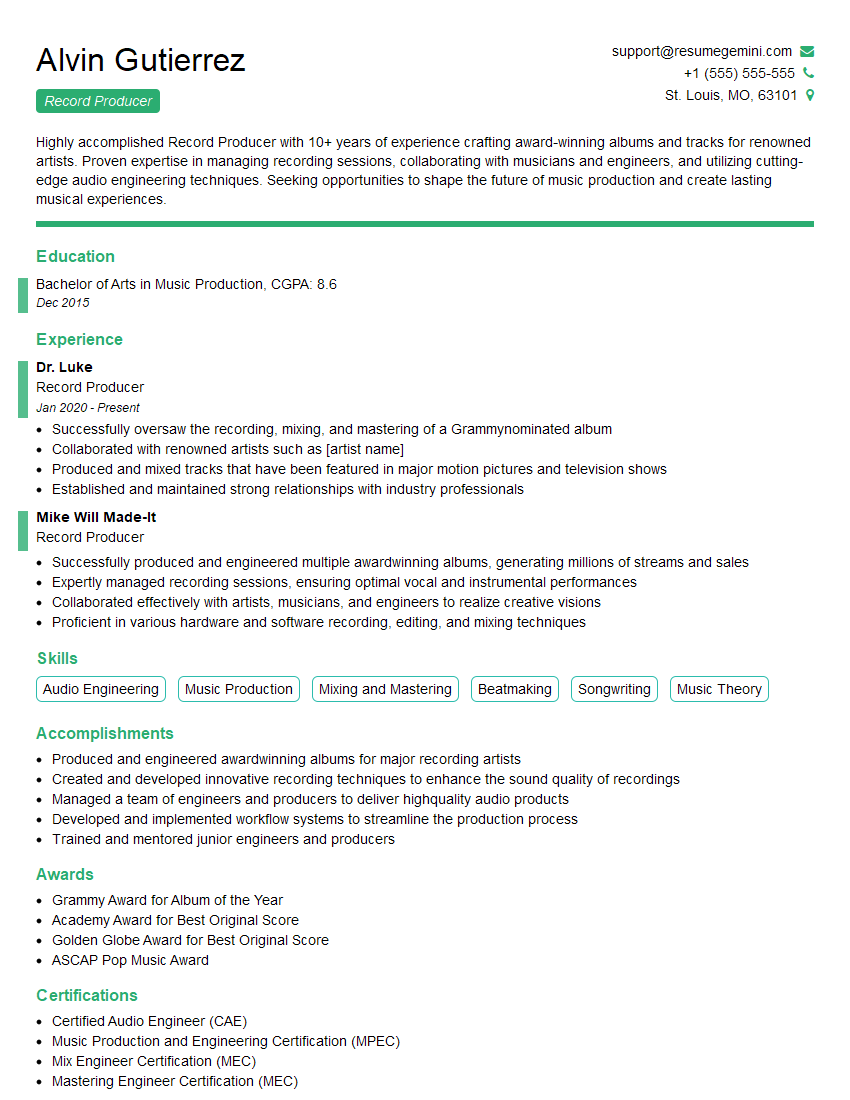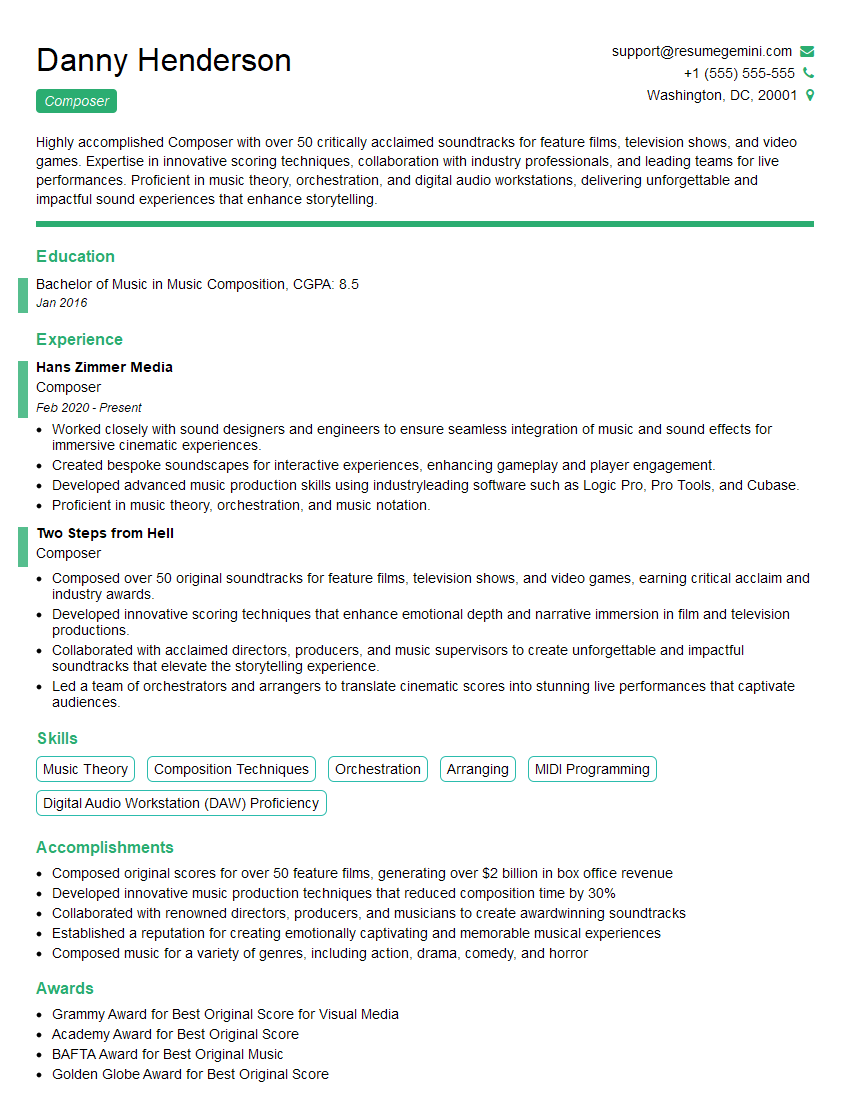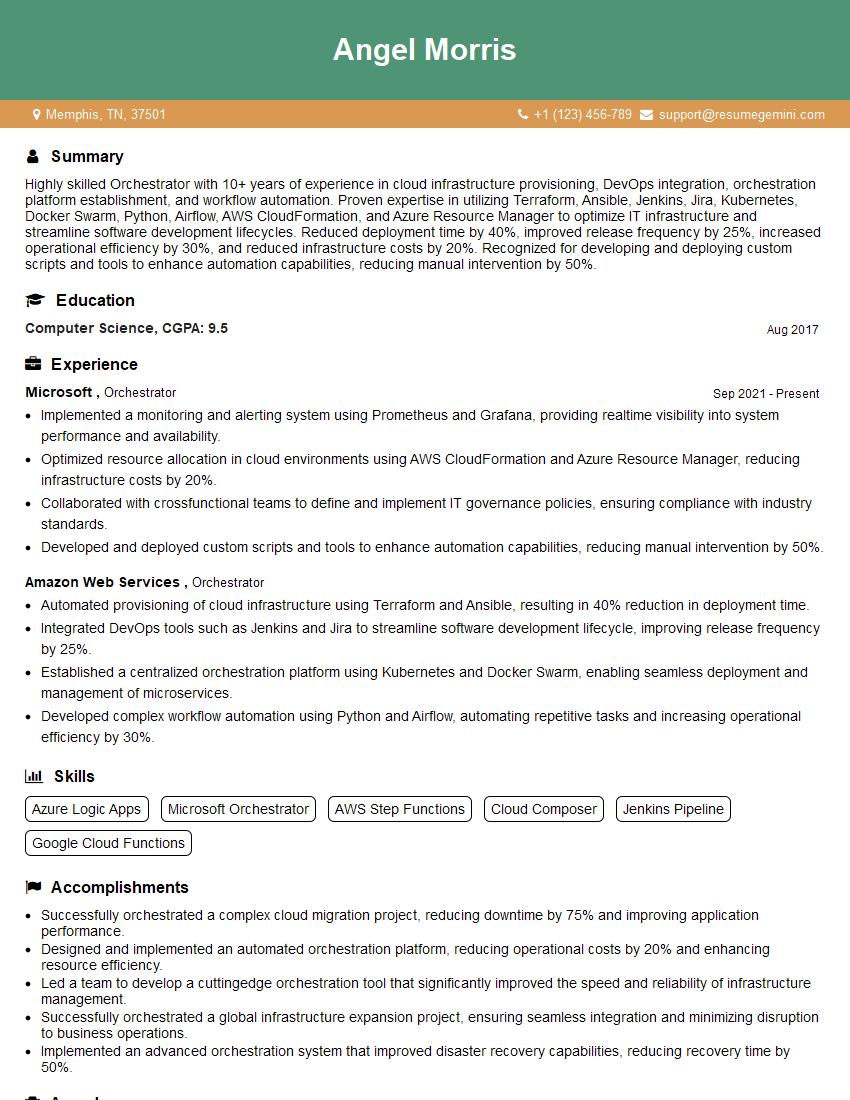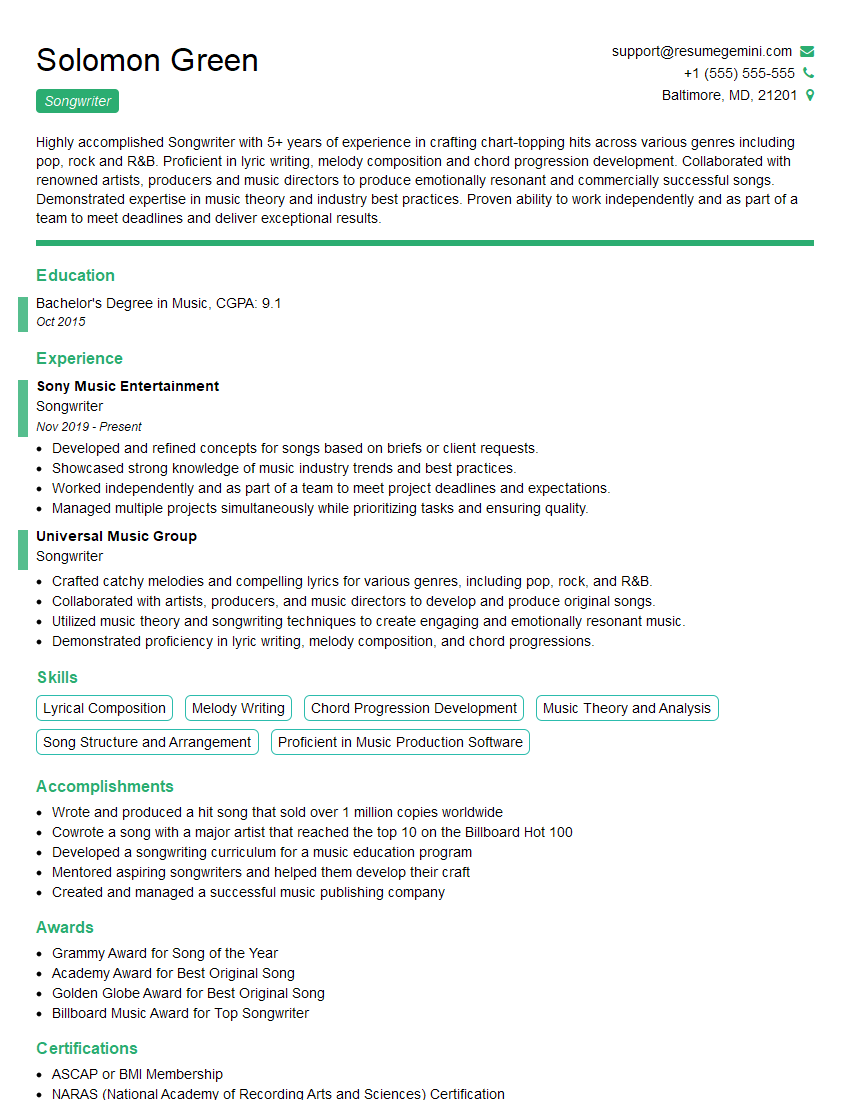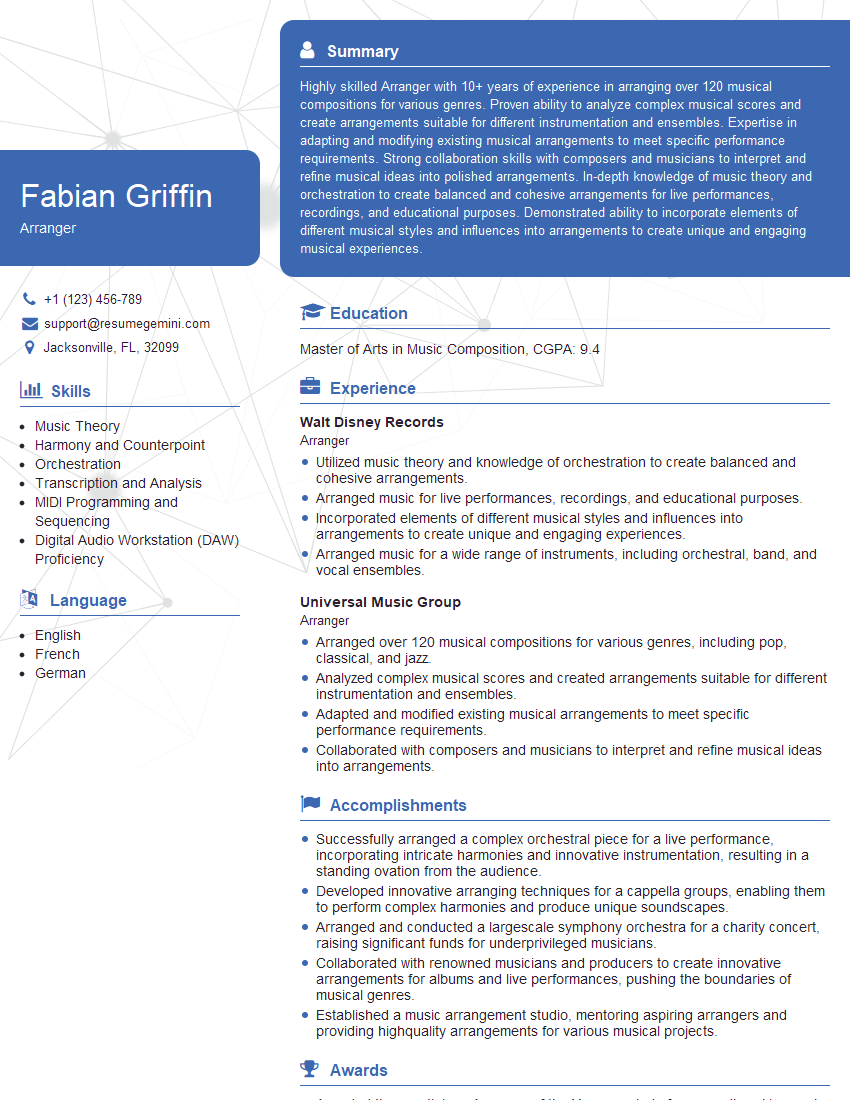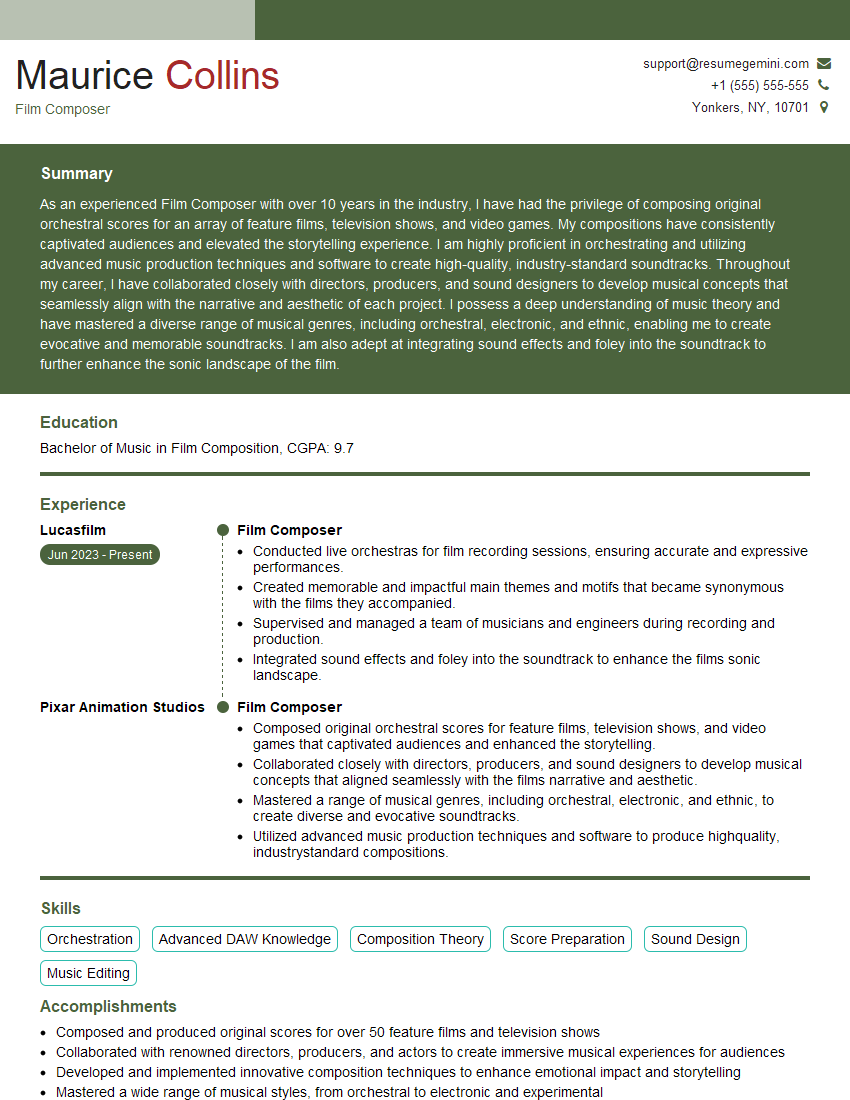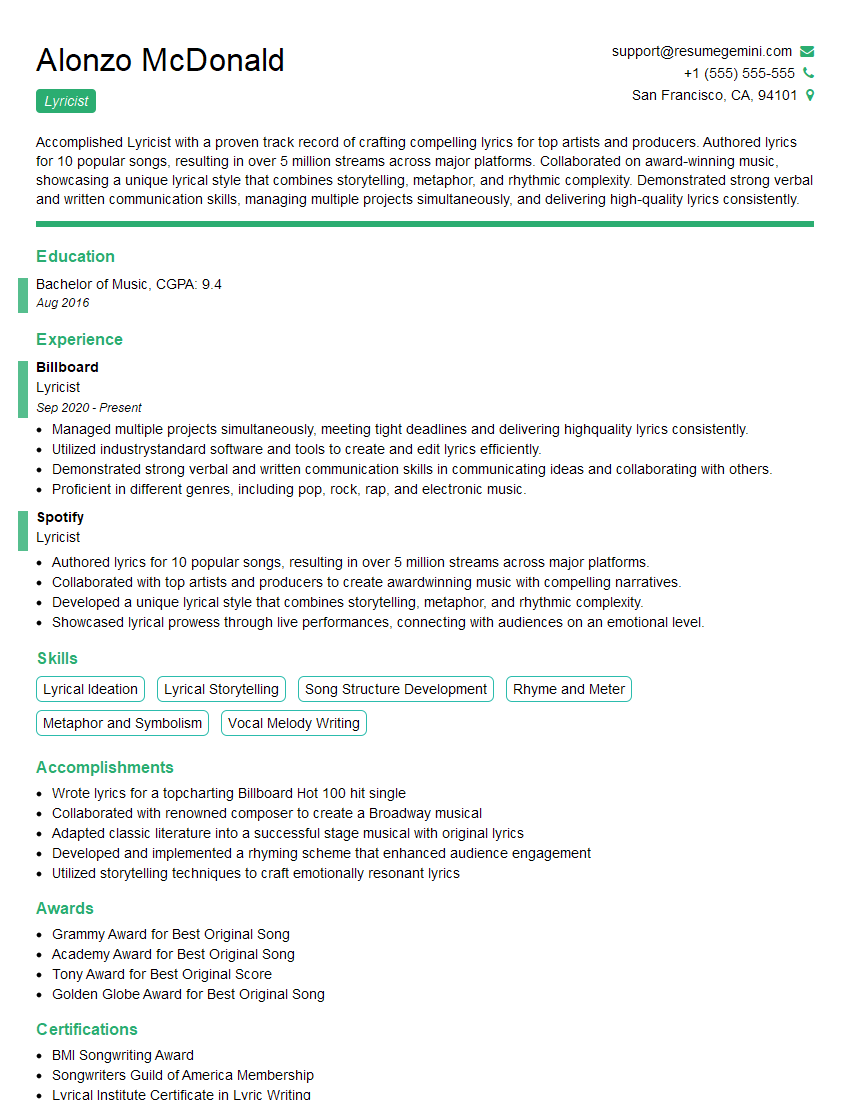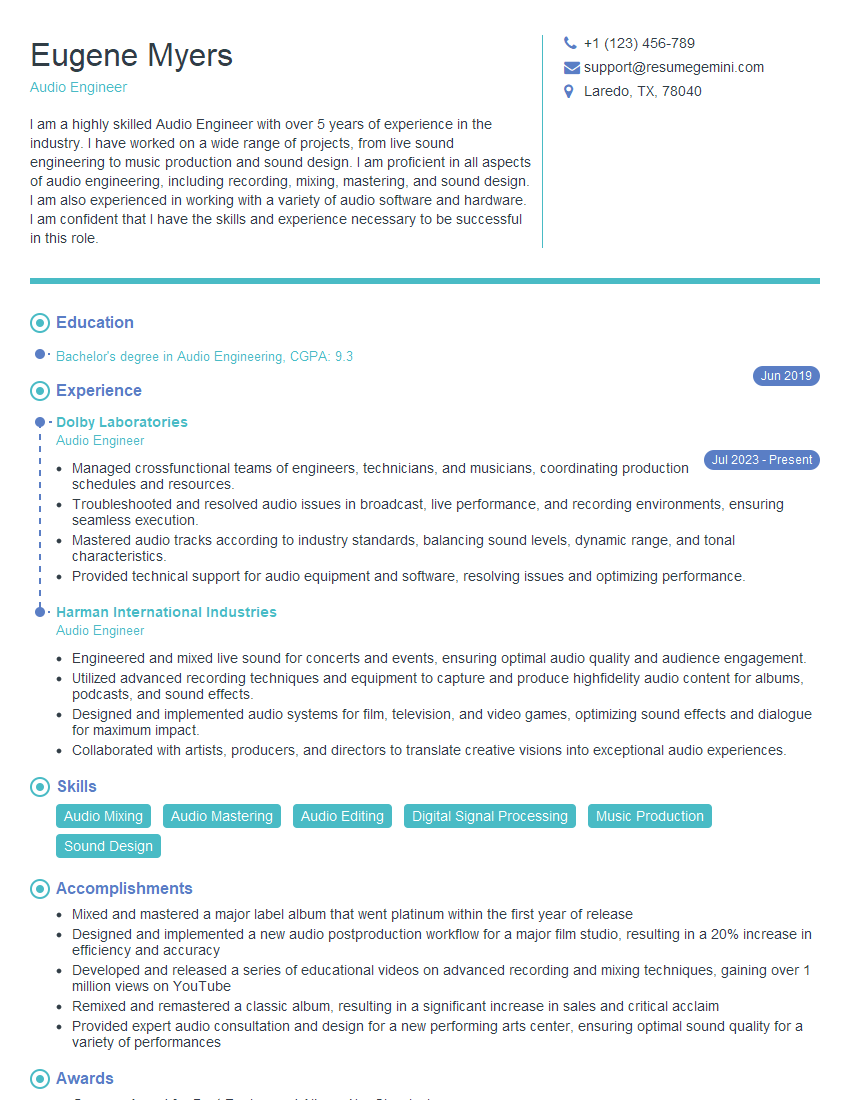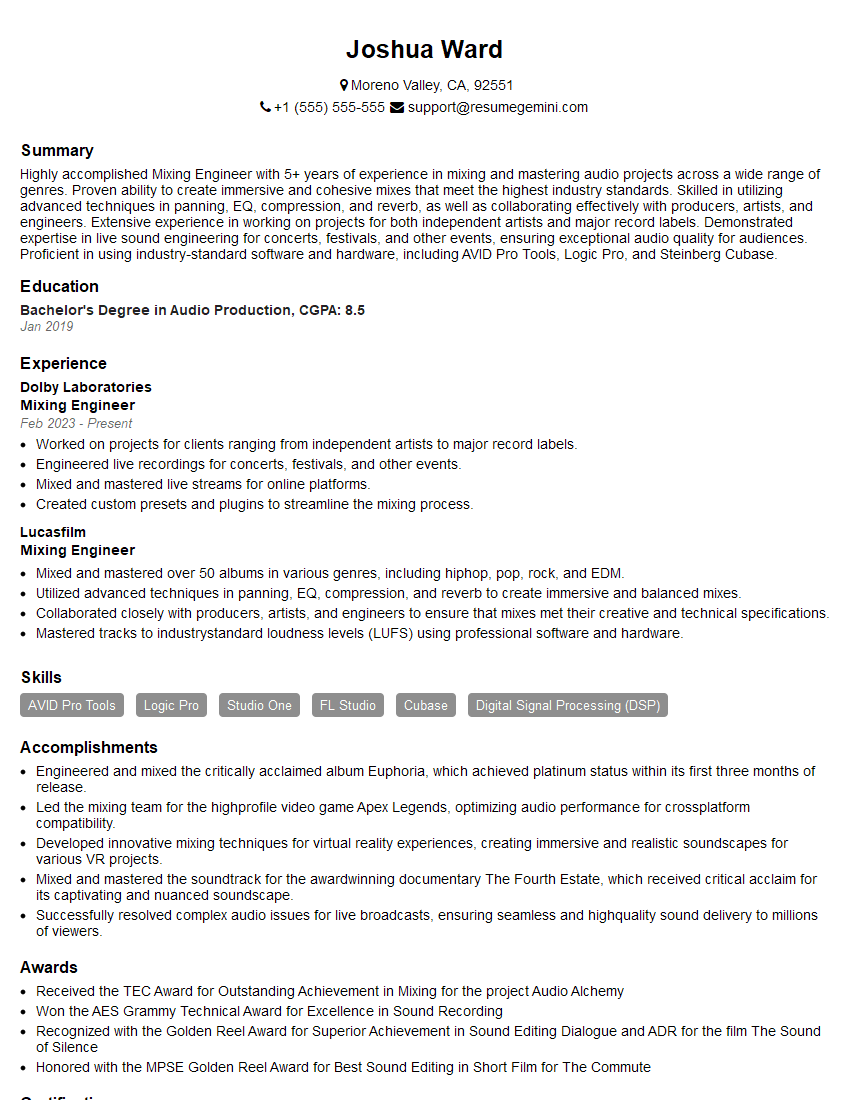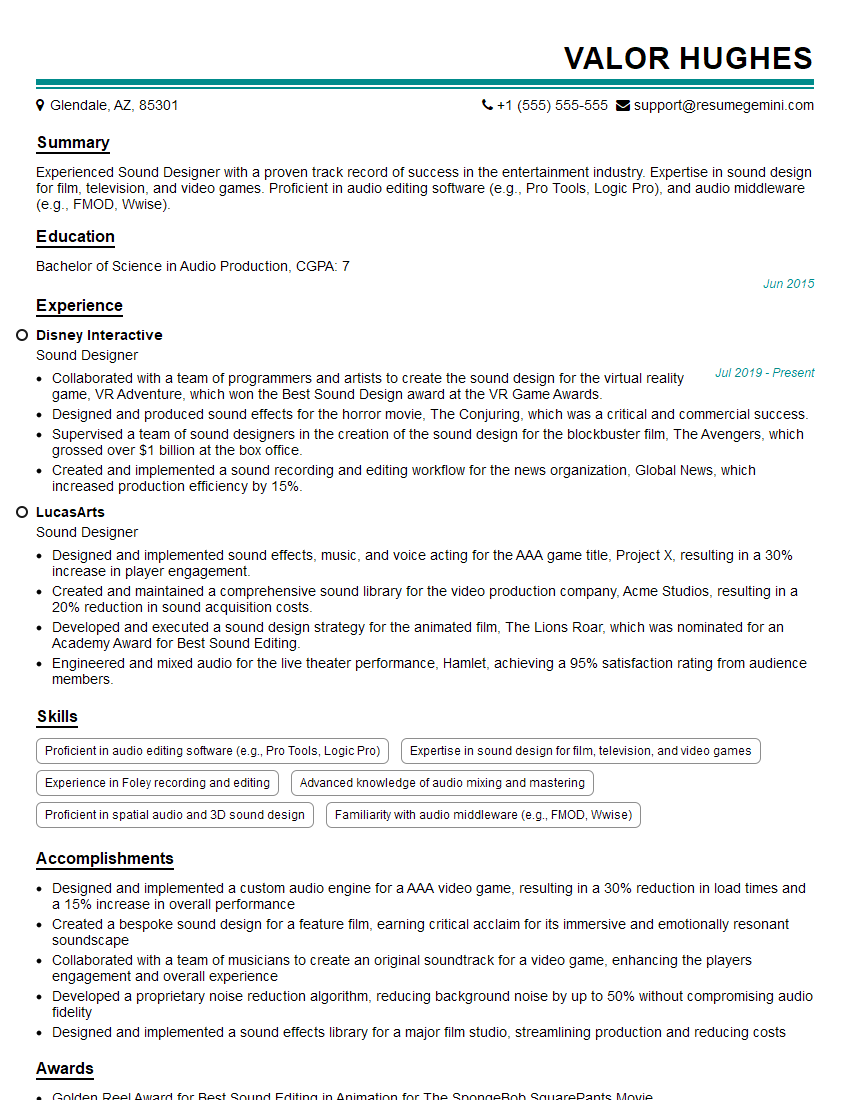Feeling uncertain about what to expect in your upcoming interview? We’ve got you covered! This blog highlights the most important Proficient in Collaborative Songwriting Techniques interview questions and provides actionable advice to help you stand out as the ideal candidate. Let’s pave the way for your success.
Questions Asked in Proficient in Collaborative Songwriting Techniques Interview
Q 1. Describe your approach to brainstorming song ideas in a collaborative setting.
My approach to collaborative brainstorming is highly structured yet flexible, aiming to maximize creativity and inclusivity. We begin with a clear objective – defining the song’s genre, target audience, and desired emotional impact. Then, I employ a multi-faceted strategy. First, we use free association: each member shares keywords, phrases, or even single words related to the theme, without judgment. This sparks unexpected connections. Secondly, we utilize ’round-robin’ brainstorming, where each person builds upon the previous idea. Thirdly, we incorporate visual brainstorming, using mood boards or mind maps to capture the song’s atmosphere and imagery. Finally, we dedicate time to individual ideation, allowing for independent reflection before reconvening to synthesize the collected ideas. This approach ensures everyone’s input is considered, avoids creative blocks, and cultivates a collaborative spirit.
For example, during a recent project aiming for an upbeat pop song about summer romance, our free association led to words like ‘sunshine,’ ‘ocean,’ ‘first kiss,’ and ‘ice cream.’ The round-robin method built upon this, transforming it into a song about two people meeting at the beach. Visual brainstorming solidified the setting and mood. Individual reflection ensured everyone felt their perspectives were equally valued before merging them.
Q 2. How do you handle creative differences with fellow songwriters?
Creative differences are inevitable and actually highly valuable in songwriting. My approach focuses on respectful dialogue and finding common ground. I encourage each songwriter to clearly articulate their vision, explaining the reasoning behind their suggestions. We actively listen, seek to understand differing perspectives, and engage in constructive criticism. Sometimes, compromising is key – blending elements from opposing ideas to reach a harmonious solution. Other times, it’s about identifying the core message and ensuring that it remains consistent throughout the song, regardless of the specific musical choices. If compromises prove impossible, I facilitate a process where we might explore multiple versions of a section and let the team choose the one they connect with the most. The goal is not to eliminate conflict but to transform it into a catalyst for innovation.
In one instance, one songwriter favored a major key while another preferred a minor key. Instead of forcing a decision, we explored both. Ultimately, we chose a verse in minor to create a sense of longing, which then transitioned into a major chorus to convey hope, thus blending both preferences into a richer overall song.
Q 3. Explain your process for integrating various musical styles into a collaborative project.
Integrating diverse musical styles requires careful planning and a willingness to experiment. We begin by identifying the dominant style and then pinpoint elements from other genres that would enhance it. This could involve incorporating rhythmic patterns from Afrobeat, melodic structures from classical music, or harmonic progressions from jazz. We use a phased approach. Firstly, we might individually explore potential stylistic blends, creating short demos to illustrate the ideas. Then, as a team, we critically evaluate these snippets, focusing on cohesion and authenticity. We discuss how to seamlessly blend the disparate elements, ensuring that the transitions are smooth and the overall aesthetic remains consistent. We may even try unconventional instrumentation or production techniques to further augment the stylistic integration. The key is mindful experimentation and critical evaluation.
For a recent project, we aimed for a pop-rock foundation, but wanted to introduce elements of flamenco guitar and Indian sitar. Each member experimented with incorporating these instruments in different sections of the song; after comparing the various implementations, we collectively decided which combination worked best to achieve the desired balance.
Q 4. How do you ensure everyone’s contributions are valued during the songwriting process?
Ensuring everyone feels valued is paramount. I achieve this through several strategies. First, I establish a culture of mutual respect and open communication from the outset. Every idea, no matter how unconventional, is met with careful consideration. We use a collaborative writing document where all contributions are clearly attributed. Second, we have dedicated ‘feedback sessions’ where each person receives constructive criticism on their work, focusing on both strengths and areas for improvement. Third, we employ a system of voting or ranking for key decisions, ensuring every voice counts. Finally, we give credit where credit is due. Every individual’s contribution is clearly acknowledged, both in the creative process and in any subsequent promotion or performance. This creates a sense of ownership and accomplishment, motivating everyone to contribute their best.
For instance, we had a songwriter who initially felt hesitant to share their ideas. By actively encouraging them, crediting their melodic contributions publicly, and praising their unique perspective, we helped them overcome their inhibition. This fostered greater participation and overall improvement in the songwriting process.
Q 5. What strategies do you use to manage conflicting schedules and deadlines in a team songwriting environment?
Managing conflicting schedules and deadlines in a collaborative environment requires meticulous planning and effective communication. We use project management tools to track progress, set realistic milestones, and assign individual responsibilities. We create a detailed timeline outlining each stage of the songwriting process – from initial brainstorming to final mixing. This timeline includes individual deadlines to ensure work is completed on schedule. We also establish clear communication channels for updates, and regular check-in meetings ensure everyone stays on track. We’re flexible – some tasks can be completed asynchronously, allowing individuals to work independently based on their availability, while others require real-time collaboration via video conferencing.
In one project, we used a shared Google Doc for lyrics and a Trello board to manage tasks and deadlines. This enabled flexibility while ensuring complete transparency.
Q 6. How do you facilitate effective communication and feedback within a songwriting team?
Effective communication and feedback are the bedrock of collaborative songwriting. We maintain open and honest dialogue, fostering a safe space where everyone feels comfortable sharing their thoughts and ideas without fear of judgment. We use clear and specific language in our feedback, focusing on the work rather than the person. We employ active listening techniques, ensuring we fully understand each other’s perspectives before responding. Regular feedback sessions, often involving constructive critiques, are an integral part of our workflow. We also leverage non-verbal communication cues to gauge emotional responses to creative ideas, ensuring that we’re all on the same page. Direct and timely communication is crucial to avoid misunderstandings and delays.
For example, rather than saying ‘This melody is bad,’ I might offer feedback such as: ‘I think this melody could be strengthened by changing the rhythm from a simple quarter note to a syncopated eighth note pattern. Could we try that?’
Q 7. Describe your experience using collaborative songwriting software or platforms.
My experience with collaborative songwriting software and platforms is extensive. I’ve worked extensively with platforms like Google Docs for lyric writing and shared file storage, which are convenient for asynchronous collaboration. I’ve also used collaborative DAWs (Digital Audio Workstations) like Soundtrap, allowing for real-time collaboration on musical arrangements. These tools are invaluable for streamlining workflow, facilitating feedback, and reducing logistical hurdles. They enable seamless integration of various instruments and vocal tracks, allowing for geographically dispersed team members to work together as if in the same studio. While familiarity with these tools is essential, the human element – clear communication and empathy – remains the most crucial factor in successful collaborative songwriting.
However, the choice of software depends on the specific needs of the project and the team’s technical capabilities. For instance, a project requiring complex audio mixing would demand a more sophisticated DAW like Logic Pro X or Pro Tools, whereas a simple lyric-writing session could be effectively handled using Google Docs.
Q 8. How do you identify and leverage the strengths of each team member in a collaborative songwriting project?
Identifying and leveraging each team member’s strengths in collaborative songwriting is crucial for a successful project. It’s like assembling a sports team – you need a balanced lineup. I start by having open discussions where each writer shares their skills and preferred roles. This might include areas like melody writing, lyric crafting, harmonic structure, or production ideas. For example, one person might excel at crafting catchy hooks, while another is a master of complex chord progressions. I then use this information to strategically assign tasks or encourage collaboration based on individual strengths. We might have a dedicated ‘melody person’ who initially crafts the main melody, which others then build upon with harmonies or counter-melodies. Similarly, someone particularly adept at storytelling could lead the lyrical development. Regular check-ins and feedback loops ensure everyone feels valued and their unique talents are utilized effectively. This fosters a sense of ownership and prevents any one person from feeling overwhelmed or sidelined.
Q 9. How do you navigate copyright and ownership issues in collaborative songwriting?
Copyright and ownership in collaborative songwriting are legally complex, but vital to address upfront. Before we even start writing, we establish a clear agreement outlining each person’s contribution and resulting ownership. This often involves a written contract specifying the percentage of ownership each songwriter holds in the song’s copyright. This can be split equally, or based on the specific contribution (e.g., someone who writes the majority of the lyrics might have a larger share). We use clear, legally sound language to avoid ambiguity. For instance, we’ll explicitly define what constitutes ‘work for hire’ if applicable. We might also detail the process for future licensing and revenue sharing. Transparency and open communication prevent future disputes. In some instances, for simpler collaborations, a less formal agreement might suffice, but even then, a written record outlining percentages of ownership is crucial. For more complex projects, legal consultation is invaluable to ensure all agreements are watertight and compliant with copyright law.
Q 10. How do you maintain creative momentum and avoid creative blocks in a team setting?
Maintaining creative momentum and avoiding blocks in a collaborative setting requires proactive strategies. We establish a regular writing schedule, even if it’s just for short bursts of time. Consistency helps build habit and prevents projects from stalling. When creative blocks arise, we employ techniques like brainstorming sessions, freewriting, or jam sessions to generate fresh ideas. We might try changing the environment – moving from a studio to a coffee shop, for example – to spark inspiration. It’s also helpful to incorporate playful elements, like challenges or constraints, to reignite creativity. For instance, we might attempt to write a song in a specific genre or using only a certain number of chords. Crucially, we foster a supportive atmosphere where everyone feels comfortable sharing ideas, even if they’re seemingly ‘bad’ ideas; they can spark something great! This openness is far more productive than silently struggling alone.
Q 11. Describe a situation where you had to compromise creatively to achieve a collaborative goal.
In one project, we were creating a song for a specific client who had a very particular vision for the vibe and message. One team member was strongly attached to a more experimental, darker lyrical approach. The client, however, preferred a more upbeat and commercially friendly sound. To achieve the collaborative goal of delivering a product the client loved, we compromised. We maintained the core melody and some of the lyrical themes the member had created but adjusted the overall tone and instrumentation to align better with the client’s brief. The compromise wasn’t about abandoning a vision entirely but about finding a way to creatively merge diverse viewpoints to satisfy both artistic expression and client requirements. The result was a song that successfully incorporated elements from everyone’s initial ideas while staying true to the client’s demands. Open discussion, clear communication, and finding common ground were key to resolving the creative differences.
Q 12. What’s your process for resolving conflicts regarding song structure or lyrical content?
Resolving conflicts about song structure or lyrical content often involves active listening and constructive feedback. We start by ensuring everyone clearly explains their perspective and the reasoning behind their ideas. We use a structured approach; sometimes we vote on options if necessary. The goal is not necessarily to make everyone completely happy, but to reach a compromise that retains the best elements of each suggestion. We prioritize objective criteria – does the structure enhance the song’s emotional impact? Does the lyric effectively convey the intended message? Subjectivity remains, but using objective guidelines helps reduce conflict. If disagreements persist, we might revisit the initial brainstorming phase to explore new directions, effectively starting with a fresh approach to the challenging sections. Sometimes, a step away from the project for a day or two helps to reset and re-approach the conflict with fresh perspectives.
Q 13. How do you ensure everyone feels equally heard and empowered in a collaborative songwriting session?
Ensuring everyone feels heard and empowered involves fostering an inclusive environment where all voices are valued. We establish ground rules for collaborative sessions that prioritize respectful communication and active listening. This includes things like ‘one person speaks at a time’ and ‘no idea is a bad idea’. We encourage each member to contribute by specifically asking for their input on different aspects of the song. We also rotate leadership roles – if one person leads a section, another leads the next – promoting a sense of shared responsibility. We ensure everyone has an equal opportunity to speak, actively managing the dynamics to prevent one or two people from dominating the conversation. Using visual aids, like mind maps or song charts, helps everyone follow the discussion and track the song’s development transparently.
Q 14. How familiar are you with various songwriting techniques, like co-writing, ghostwriting, and work-for-hire agreements?
I’m very familiar with various songwriting techniques. Co-writing is the most common form of collaborative songwriting, where multiple writers contribute equally to the creation of a song and share ownership. Ghostwriting involves writing a song for another artist, who receives credit while the ghostwriter remains uncredited. It’s crucial to have clear agreements about ownership and compensation in ghostwriting projects. Work-for-hire agreements are typically used in commercial songwriting, where a writer is hired to create a song for a specific purpose, and the copyright is typically owned by the party who commissioned the work. Understanding the nuances of each technique, including the legal ramifications, is essential for successfully navigating the complexities of the music industry. The specific terms of each contract must be clearly defined and agreed upon to avoid later disputes. Each model offers different levels of creative control and financial reward. Knowing which model best suits a specific project is critical for its success.
Q 15. How do you balance your own creative vision with the contributions of other songwriters?
Balancing individual vision with collaborative input is crucial in songwriting. Think of it like a jazz ensemble – each musician has their own unique voice but plays within the structure of the overall piece. My approach starts with a clear articulation of my initial concept, be it a melody, lyric idea, or overall mood. I then create a safe space where others feel comfortable sharing their ideas, emphasizing that no suggestion is ‘wrong’ during the brainstorming phase. We actively discuss each contribution, evaluating how well it complements the existing framework and explores new directions. Compromise is key; it’s about finding the best possible synthesis, not forcing my vision onto the group. For instance, on one project, I had a strong melody but the lyrics weren’t quite right. A collaborator suggested a different lyrical approach, and the resulting combination created a much more powerful and resonant song. The key is to remain open to suggestions, even those initially seem contradictory to the initial vision, and then to use that feedback and to selectively use that to enhance the final product.
Career Expert Tips:
- Ace those interviews! Prepare effectively by reviewing the Top 50 Most Common Interview Questions on ResumeGemini.
- Navigate your job search with confidence! Explore a wide range of Career Tips on ResumeGemini. Learn about common challenges and recommendations to overcome them.
- Craft the perfect resume! Master the Art of Resume Writing with ResumeGemini’s guide. Showcase your unique qualifications and achievements effectively.
- Don’t miss out on holiday savings! Build your dream resume with ResumeGemini’s ATS optimized templates.
Q 16. Describe your experience working with different musical genres in a collaborative context.
My experience spans various genres, from folk to pop, electronic to R&B. The collaborative process adapts to each genre’s unique characteristics. For example, in a folk context, the emphasis may be on storytelling and lyrical depth, with instrumentation remaining relatively simple. Collaborations in electronic music often involve layering sounds and experimenting with diverse sonic palettes. Working across genres expands creative horizons and challenges preconceived notions. In one project blending pop and electronic elements, initial disagreements on the instrumentation resolved into a truly innovative sound when we adopted a ‘mashup’ approach. We initially wrote individual pop melodies, then blended those with complex electronic soundscapes, creating a unique sonic identity.
Q 17. How would you handle a situation where a team member is not contributing effectively?
Addressing ineffective contributions requires sensitivity and direct, yet constructive, communication. It’s not about blaming but about understanding the root cause. I start by privately engaging with the team member, fostering open dialogue. We discuss their perceived lack of contribution, explore any potential roadblocks (time constraints, creative block, lack of clarity on the project’s direction), and work collaboratively on solutions. This may involve assigning specific tasks tailored to their strengths, providing additional support, or simply providing clear expectations and deadlines. If the issue persists, it may be necessary to reassess their role in the project, or if that’s not possible, to politely but firmly end the collaboration, emphasizing that this decision is about the project’s overall success and not a reflection of the individual’s talent.
Q 18. How do you measure the success of a collaborative songwriting project?
Measuring success in collaborative songwriting isn’t solely about chart performance. It’s a multifaceted evaluation. We consider factors like the creative process itself—was it enjoyable, productive, and collaborative? Did we achieve our artistic goals? Did the song fulfil its intended purpose (e.g., tell a story, evoke emotion, express a message)? We also look at the reception of the song from audiences, critics, or industry professionals, analyzing things like streaming numbers, radio play, and critical reviews. Finally, and perhaps most importantly, we consider whether the song is authentic and meaningful to us, reflecting a true collaboration and the individual voices involved.
Q 19. How do you deal with constructive criticism during the songwriting process?
Constructive criticism is essential for growth. I approach it as an opportunity to refine and improve the song, not as a personal attack. I actively listen to feedback, asking clarifying questions to ensure I fully understand the perspective offered. I try to detach my emotions from the process and examine the criticism objectively. Sometimes I’ll even incorporate direct feedback (i.e., specific lyric changes or suggested instrumentation), but if I’m not certain about a given piece of criticism, I’ll hold off on implementing it and instead revisit the topic at a later point in the process. If I can’t adapt to the criticism, it doesn’t mean that it’s wrong, but we will openly discuss why and what needs to be done so the final product reflects the group’s creative vision.
Q 20. What are some common pitfalls to avoid in collaborative songwriting?
Common pitfalls include unclear communication, unequal contributions, unresolved creative differences, and a lack of defined roles and responsibilities. To avoid these, establishing clear communication channels (regular meetings, shared online documents), defining roles from the outset, and encouraging open discussion about creative disagreements are crucial. Setting realistic expectations and deadlines helps manage workflow effectively. One example of a disastrous collaboration I’ve been a part of was where we didn’t establish clear songwriting roles, so we ended up having a completely disorganized structure that never coalesced into a finished product. We learned that clear communication and an open dialogue can drastically improve the outcome of a songwriting project.
Q 21. How do you ensure the integrity of the original creative vision in a collaborative project?
Maintaining the integrity of the original vision requires a delicate balance between collaboration and creative leadership. This begins with clearly articulating the initial concept and establishing a collaborative framework that respects both individual contributions and the overall direction. Regular check-ins, where we review the progress in relation to the initial vision, help to ensure everyone stays on track. Openly discussing any potential deviations and finding solutions collaboratively prevents the project from veering too far off course. While adapting is crucial, a strong initial vision serves as a guiding light that ensures the collaborative spirit remains grounded and doesn’t derail the fundamental artistic goals of the piece. It’s all about respecting both the original intent and the value that collaboration can add.
Q 22. Describe your preferred method for assigning tasks and responsibilities within a songwriting team.
My preferred method for assigning tasks and responsibilities in a songwriting team is highly collaborative and flexible, adapting to the strengths and preferences of each member. We avoid rigid roles. Instead, we begin by brainstorming the overall concept and structure of the song, identifying key sections like verses, choruses, bridges, and outros. Then, we discuss each member’s particular strengths: Is someone a melody whiz? A lyrical genius? A rhythmic master? Based on this, individuals may naturally gravitate toward particular tasks, but there’s always open communication and the possibility of trading sections or offering input across the board. For instance, one person might write the initial verse lyrics, while another crafts the melody, and a third develops the rhythmic accompaniment. We always encourage experimentation and cross-pollination of ideas.
For example, in a recent project, one writer excelled at crafting evocative lyrics, while another had a knack for catchy melodies. I facilitated a process where the lyricist focused initially on verse construction, providing drafts for the melodist to build upon. Simultaneously, another team member worked on the harmonic structure. This organic approach allowed for natural specialization while preserving the collaborative spirit.
Q 23. How do you maintain a positive and productive collaborative environment?
Maintaining a positive and productive collaborative environment requires consistent effort and a proactive approach. Open communication is paramount. We establish clear channels for feedback—regular check-ins, dedicated brainstorming sessions, and constructive critique sessions—ensuring everyone feels heard and valued. We explicitly embrace a culture of mutual respect, encouraging vulnerability and the sharing of both successes and challenges. Building trust is also crucial, fostering an atmosphere where team members feel safe to take creative risks without fear of judgment. Respecting individual work styles is critical; some thrive on structured environments, while others prefer more organic processes. We celebrate milestones and acknowledge contributions, reminding everyone that the collaborative process is a shared journey, not a competition.
For instance, if disagreements arise about a particular melodic line, I facilitate a discussion where each person explains their perspective. We often approach it as a problem-solving exercise, exploring alternative approaches rather than forcing a singular ‘correct’ version. Conflict is considered an opportunity for creative growth. We also find that regular breaks and social time can significantly improve morale and team cohesion, making the creative process more enjoyable and less stressful.
Q 24. What strategies do you use to prevent creative stagnation in a long-term songwriting project?
Creative stagnation in long-term projects is a common challenge. To combat it, we employ several strategies. First, we actively seek external input. This might involve playtesting sections of the song with a focus group or seeking feedback from trusted colleagues outside the immediate team. Secondly, we incorporate intentional breaks and changes of pace. This could be anything from a brief respite to work on individual projects to a dedicated brainstorming session focused on entirely different musical directions. Thirdly, we engage in experimental exercises, deliberately stepping outside our comfort zones. This could be trying different genres, incorporating unusual instrumentation, or exploring unconventional lyrical approaches. Finally, we regularly revisit our initial vision and goals, ensuring we’re still on track and passionate about the project’s direction.
One project involved a lengthy instrumental piece, and we experienced a creative plateau. To overcome this, we spent a day improvising with instruments that were not typically used in our music, which sparked new ideas. We also brought in a guest artist to provide fresh perspective and collaborative energy.
Q 25. How do you handle revisions and feedback during the collaborative songwriting process?
Handling revisions and feedback is a delicate process requiring tact and diplomacy. We employ a structured approach. All feedback is presented constructively, focusing on specific aspects rather than broad, sweeping critiques. For example, instead of saying ‘this is boring,’ a more helpful comment would be ‘the melody in this section feels somewhat predictable; perhaps exploring a more unexpected harmonic progression could add interest.’ We use collaborative software that allows for version control, enabling us to track changes and revert to previous versions if needed. Every suggestion is carefully considered and discussed; nothing is dismissed outright without explanation. The final decision often involves a compromise that integrates the best aspects of various suggestions.
We frequently use a ’round-robin’ feedback system, ensuring that everyone gets a chance to offer input on each other’s work. This fosters a sense of ownership and shared responsibility in the final product.
Q 26. Explain your approach to sharing songwriting credits fairly among collaborators.
Fairly sharing songwriting credits is crucial for maintaining positive team dynamics. We adopt a transparent and collaborative approach. From the outset, we establish a clear understanding of the contribution each member will make. This might involve outlining specific tasks or roles. As the project progresses, we track each person’s contributions, noting who wrote which sections, created what melodies, provided key lyrical ideas, and arranged specific musical elements. This documentation helps avoid future disputes. For complex contributions, we may use a weighting system to reflect the relative importance of each member’s input. It is essential that the credit distribution is agreed upon collectively, with all parties having a voice in the decision-making process.
For example, in a song where one person contributed the main melody and another wrote the lyrics, the credits might reflect a 50/50 split. However, in cases with more nuanced contributions, we might have a more detailed breakdown, reflecting individual contributions accurately.
Q 27. How do you maintain a healthy work-life balance while working on collaborative songwriting projects?
Maintaining a healthy work-life balance while engaged in collaborative songwriting is absolutely vital to prevent burnout and maintain creative energy. We establish realistic timelines and deadlines, avoiding unrealistic expectations. Regular breaks and time off are essential, built into the project schedule from the beginning. Open communication about individual capacity and workload is key. Team members are encouraged to communicate if they’re feeling overwhelmed, and we work together to adjust workloads or timelines as needed. Setting boundaries is crucial; this might mean dedicating specific times to work on the project and strictly adhering to those timeframes. Finally, we emphasize the importance of pursuing other hobbies and interests outside of the project to prevent creative exhaustion and maintain overall well-being.
For example, we might establish a ‘no-work’ rule after 6 PM on weekdays to encourage a proper separation between work and personal life. This enables us to maintain a sense of balance and prevent the project from consuming our entire lives.
Key Topics to Learn for Proficient in Collaborative Songwriting Techniques Interview
- Idea Generation & Brainstorming: Understanding various techniques for collaborative ideation, from free association to structured brainstorming sessions. Practical application: Describe your experience in contributing creative ideas within a team environment, and how you navigated differing opinions.
- Lyrical Collaboration: Strategies for merging different lyrical styles and perspectives into a cohesive whole. Practical application: Explain how you’ve addressed conflicting lyrical visions in a past project, and the solutions you implemented to reach a consensus.
- Melody & Harmony Development: Techniques for crafting memorable melodies and harmonies collaboratively, considering individual strengths and preferences. Practical application: Detail your experience working with other musicians to develop musical ideas, outlining your role in the process and how you contributed to the final product.
- Structural Collaboration: Approaches to collaboratively structuring a song, from verse-chorus arrangements to more experimental forms. Practical application: Discuss how you’ve contributed to the overall structure of a song, including decisions about song form, arrangement, and transitions.
- Conflict Resolution & Communication: Effective communication strategies for navigating creative differences and resolving conflicts respectfully and productively. Practical application: Describe a situation where creative differences arose within a songwriting team, and explain the steps you took to resolve the conflict while maintaining a positive working relationship.
- Copyright & Legal Aspects: Understanding the legal framework surrounding collaborative songwriting, including co-writing credits and royalty splits. Practical application: Discuss your understanding of songwriting contracts and the importance of fair and transparent agreements within a collaborative setting.
- Technological Proficiency: Familiarity with digital audio workstations (DAWs) and other collaborative songwriting tools. Practical application: Demonstrate your knowledge of relevant software and your ability to use technology to facilitate collaborative songwriting processes.
Next Steps
Mastering proficient collaborative songwriting techniques is crucial for career advancement in the music industry, opening doors to diverse opportunities and enhancing your marketability. To maximize your job prospects, it’s essential to create an ATS-friendly resume that effectively highlights your skills and experience. We strongly encourage you to leverage ResumeGemini, a trusted resource for building professional resumes. ResumeGemini can help you craft a compelling narrative that showcases your collaborative songwriting abilities. Examples of resumes tailored to showcasing proficiency in collaborative songwriting techniques are available to help guide your resume development.
Explore more articles
Users Rating of Our Blogs
Share Your Experience
We value your feedback! Please rate our content and share your thoughts (optional).
What Readers Say About Our Blog
Hello,
We found issues with your domain’s email setup that may be sending your messages to spam or blocking them completely. InboxShield Mini shows you how to fix it in minutes — no tech skills required.
Scan your domain now for details: https://inboxshield-mini.com/
— Adam @ InboxShield Mini
Reply STOP to unsubscribe
Hi, are you owner of interviewgemini.com? What if I told you I could help you find extra time in your schedule, reconnect with leads you didn’t even realize you missed, and bring in more “I want to work with you” conversations, without increasing your ad spend or hiring a full-time employee?
All with a flexible, budget-friendly service that could easily pay for itself. Sounds good?
Would it be nice to jump on a quick 10-minute call so I can show you exactly how we make this work?
Best,
Hapei
Marketing Director
Hey, I know you’re the owner of interviewgemini.com. I’ll be quick.
Fundraising for your business is tough and time-consuming. We make it easier by guaranteeing two private investor meetings each month, for six months. No demos, no pitch events – just direct introductions to active investors matched to your startup.
If youR17;re raising, this could help you build real momentum. Want me to send more info?
Hi, I represent an SEO company that specialises in getting you AI citations and higher rankings on Google. I’d like to offer you a 100% free SEO audit for your website. Would you be interested?
Hi, I represent an SEO company that specialises in getting you AI citations and higher rankings on Google. I’d like to offer you a 100% free SEO audit for your website. Would you be interested?
good
